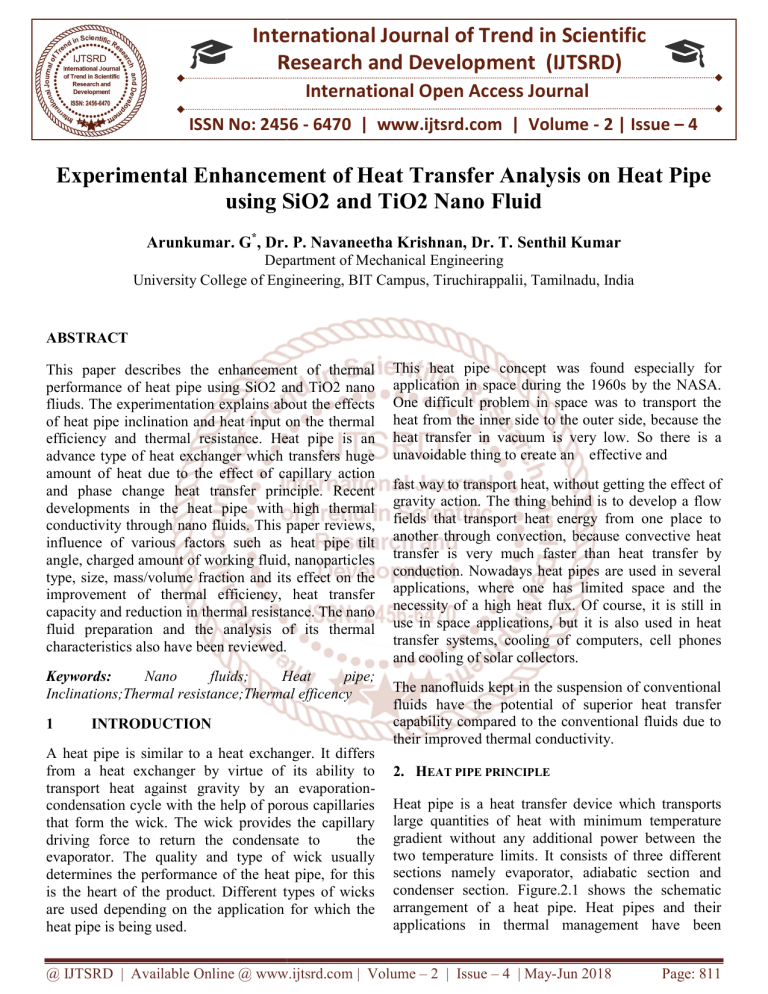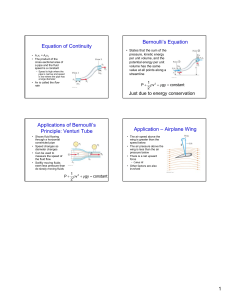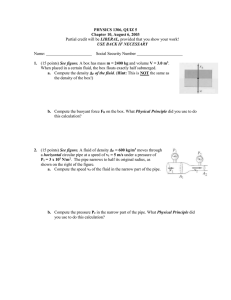
International Journal of Trend in Scientific
Research and Development (IJTSRD)
International Open Access Journal
ISSN No: 2456 - 6470 | www.ijtsrd.com | Volume - 2 | Issue – 4
Experimental Enhancement off Heat Transfer Analysis on Heat Pipe
using
sing Si
SiO2 and TiO2 Nano Fluid
Arunkumar. G*, Dr. P. Navaneetha Krishnan, Dr. T. Senthil Kumar
Department of Mechanical Engineering
University College of Engineering, BIT Campus, Tiruchirappalii, Tamilnadu, India
ABSTRACT
This paper describes the enhancement of thermal
performance of heat pipe using SiO2 and TiO2 nano
fliuds. The experimentation explains about the effects
of heat pipe inclination and heat input on the thermal
efficiency and thermal resistance. Heat pipe is an
advance type of heat exchanger which transfers huge
amount of heat due to the effect of capillary action
and phase change heat transfer principle. Recent
developments in the heat pipe with high thermal
conductivity through nano fluids. This paper review
reviews,
influence of various factors such as heat pipe tilt
angle, charged amount of working fluid, nanoparticles
type, size, mass/volume fraction and its effect on the
improvement of thermal efficiency, heat transfer
capacity and reduction in thermal resistanc
resistance. The nano
fluid preparation and the analysis of its thermal
characteristics also have been reviewed.
Keywords:
Nano
fluids;
Heat
pipe;
Inclinations;Thermal resistance;Thermal efficency
1
INTRODUCTION
A heat pipe is similar to a heat exchanger. It differs
from a heat exchanger by virtue of its ability to
transport heat against gravity by an evaporation
evaporationcondensation cycle with the help of porous capillaries
that form the wick. The wick provides the capillary
driving force to return the condensate to
the
evaporator.
vaporator. The quality and type of wick usually
determines the performance of the heat pipe, for this
is the heart of the product. Different types of wicks
are used depending on the application for which the
heat pipe is being used.
This heat pipe concept was found especially for
application in space during the 1960s by the NASA.
One difficult problem in space was to transport the
heat from the inner side to the outer side, because the
heat transfer in vacuum is very low. So there is a
unavoidable thing to create an effective and
fast way to transport heat, without getting the effect of
gravity action. The thing behind is to develop a flow
fields that transport heat energy from one place to
another through convection, because convective heat
transfer is very much faster than heat transfer by
conduction. Nowadays heat pipes are used in several
applications, where one has limited space and the
necessity of a high heat flux. Of course, it is still in
use in space applications, but it is also used in heat
transfer
ansfer systems, cooling of computers, cell phones
and cooling of solar collectors.
The nanofluids kept in the suspension of conventional
fluids have the potential of superior heat transfer
capability compared to the conventional fluids due to
their improved
d thermal conductivity.
2. HEAT PIPE PRINCIPLE
Heat pipe is a heat transfer device which transports
large quantities of heat with minimum temperature
gradient without any additional power between the
two temperature limits. It consists of three different
sections namely evaporator, adiabatic section and
condenser section. Figure.2.1 shows the schematic
arrangement of a heat pipe. Heat pipes and their
applications in thermal management have been
@ IJTSRD | Available Online @ www.ijtsrd.com | Volume – 2 | Issue – 4 | May-Jun
Jun 2018
Page: 811
International Journal of Trend in Scientific Research and Development (IJTSRD) ISSN: 2456-6470
2456
studied for decades. They constitute an efficient,
compact tooll to dissipate substantial amount of heat
from various engineering systems including electronic
components. Heat pipe has ability to dissipate huge
amount of heat with small temperature drop along the
heat pipe while providing a self-pumping
pumping capable
throughh a porous material in its structure. A limiting
factor for the heat transfer potential of a heat pipe is
depends
working
fluid
properties.
The
thermophysical properties of the fluid can be
improved. An innovative way to enhance liquid
thermal conductivityy is the dispersion of highly
conductive solid nanoparticles within the base fluid.
Copper heat pipe and stainless steel heat pipe as
shown in figure 2.1from walunj A.A,pathan F.Z[1].
of the menisci at the vapor interface coupled with the
surface tension of the working fluid causes a capillary
pressure gradient at the liquid-vapor
liquid
interface along
the length of the pipe. This capillary pressure gradient
pumps
ps the working fluid against various pressure
losses such as friction, inertia and against bulk body
forces. This axial variation of pressure is illustrated in
Figure 2.2
Figure 2.2 Pressure variation along a heat pipe
3. EXPERIMENTAL SETUP
Figure 2.1 Simple Heat Pipe
Traveling through the adiabatic section the vapor
reaches the condenser region where condensation
rejects the latent heat of the fluid to the sink. The
condensed liquid is pumped back against an adverse
pressure gradient to the evaporator by a combination
of the capillary pumping action and/or bulk forces.
This fluid circuit is repeated during the normal
operation of the heat pipe and can continue as long as
there is sufficient vapor pressure and capillary
pressure to support its operation. Simple heat pipe as
shown Figure 2.1.
At the evaporator end the liquid recedes into the wick
pores and hence the menisci in the pores at the vapor
interface are highly curved. Whereas the liquid
menisci at vapor interface in the condenser end are
almost flat. This difference
nce in the interface curvature
A heat pipe is broadly divided in three sections
namely, evaporator, adiabatic and condenser. A
typical heat pipe as shown in Figure 3.1 has one
evaporator section that takes heat from a source. The
heat absorbed in the evaporator causes change of
phase of the working fluid from liquid to vapor. The
increased vapor pressure in the evaporator causes the
vapor to exit from the evaporator section and travel
through the adiabatic section.
The length of evaporation section is 300mm and
adiabatic section is 400mm and condenser
condens section is
300mm. A wire mesh made up of stainless steel
material to place inside of the copper tube.There are
three K type thermocouples fixed on the top surface
of the stainless steel tube by using M-Seal.
M
The temperature values are displayed by temperature
indicator. The temperature range of the thermocouple
is -200°c to 1400°c.
A nichrome coil was wounded on the evaporator
section only.
The evaporator and adiabatic sections are covered by
Glass Wool.
@ IJTSRD | Available Online @ www.ijtsrd.com | Volume – 2 | Issue – 4 | May-Jun
Jun 2018
Page: 812
International Journal of Trend in Scientific Research and Development (IJTSRD) ISSN: 2456-6470
2456
prolonged stages in
n the preparation. Magnetic Strier
as shown Figure 4.1.
Figure 3.1 Experimental Setup
The evaporator section was heated by a nichrome coil
surrounding at its circumference and the power supply
to the Nichrome coil was given by auto transformer.
The condensation section cooled the nano fluid by
temperature of atmospheric
mospheric air. To minimize the heat
loss the evaporator and adiabatic section was
insulated by using glass wool. The heat pipe was
arranged in different angles like 0o, 30o, 45o, 60o by
using the wooden stand. Schematic diagram of heat
pipe as shown in Figure 3.2.
Figure 4.1 Magnetic Strier
In current experimental study, silicon dioxide of
0.1%,0.25%,0.50%,0.75% mass concentration is used
and the reason for choosing silicon is due to its
widely known thermal properties and easy to blend.
The silicon dioxide Nano particles are purchased from
a commercial trader. The properties of the Nano fluid
are average particles size= 50 nm, Density=2650,
Thermal conductivity= 1.38 W/m/K, specific heat=
703 J Kg-1 K-1,
1, The required volume fraction of
0.1%, 0.25%, 0.50%, 0.75% was prepared by
blending the specified
pecified quantity in distilled water from
Kakaça S [3]. Table 4.1 shows the mass of SiO2 and
TiO2 nanoparticles various volume concentration of
nanofluid.
Table 4.1 Volume concentration of nanofluids
Figure 3.3 Schematic diagram of heat pipe
4. PREPARATION OF NANOFLUIDS
The preparations of Nano fluid include as the
production of Nano based particles and then blend
into the base fluid. The two methods are used to
prepare the Nano fluids are single-step
step method and
two-step
step method. For the preparation of SiO2
particles, two-step
step method is more suitable. In the two
step method, initially nano–scale
scale sized metals, metal
oxides, fiber particles and carbon nanotubes
(CNT/NCT) are prepared.
The above table 4.1 infers the volume concentrations
for
or Sio2 and TiO2 nano fluids from LamasB[4].
Then thee dry powder is produced by various processes
like chemical vapor condensation, mechanical
alloying, etc. Thereafter, it is dispersed in the base
fluids
from
Negin
Monirimanesh[2].
The
agglomeration is high in this method, because of its
@ IJTSRD | Available Online @ www.ijtsrd.com | Volume – 2 | Issue – 4 | May-Jun
Jun 2018
Page: 813
International Journal of Trend in Scientific Research and Development (IJTSRD) ISSN: 2456-6470
2456
5. CALCULATION
= 20 / 0.0376x3
h Sio2 = 177.39 w/m2 °c
5.1 FORMULA
1.
R= Te-Tc / Q (°C/W)
Where,
2.
R= Thermal Resistance (°C/W)
Q= Power (W)
Te= Evaporator Temperature (°C)
Tc= Condenser Temperature (°C)
6. RESULTS AND DISCUSSIONS:
FOR SILICON DI OXIDE (SiO2)
Q= VxI in Watts
Where, V= voltage (V)
I =Current (A)
3.
h= Q/A (Te-Tc) w/m2 °c
Where, h= Heat Transfer Co-Efficient
Efficient
A= Area Of Heat Pipe
4.
A = πdl in m2
Where, d= Diameter Of The Heat Pipe In m
l = Length Of The Heat Pipe In m
5.2 CALCULATION OF THERMAL
RESISTANCE
For 0.1 Concentration At 0 Degree
1. Q = VxI
= 100x0.2
Figure 6.1 Experimental results for SiO2 nano fluid
The above figure infers that the thermal resistance of
Sio2 nanofluid at 00, 300, 450 and 600 angle of
inclination of heat pipe for various concentrations:For
0.10, minimum Thermal Resistance is 0.47. For 0.25,
minimum Thermal Resistance is 0.47. For 0.50,
minimum Thermal Resistance is 0.47. For 0.75,
minimum Thermal Resistance is 0.45.
Q = 20 Watts
2. RSio2 = Te-Tc / Q
FOR TITANIUM OXIDE (TiO2)
= (30-27) / 100
RSio2 = 0.15 °c/w
5.3 CALCULATION OF HEAT TRANSFER CO
COEFFICIENT
For 0.1 Concentration At 0 Degree
1.
𝐴 = 𝜋dl d = 12 mm = 0.012m l =
1000mm=1.0 m
= 𝜋x0.012x1
A = 0.0376 m2
2.
h Sio2 = Q/A(Te-Tc) w/m2 °c
Figure 6.1 Experimental results for TiO2 nano fluid
@ IJTSRD | Available Online @ www.ijtsrd.com | Volume – 2 | Issue – 4 | May-Jun
Jun 2018
Page: 814
International Journal of Trend in Scientific Research and Development (IJTSRD) ISSN: 2456-6470
The above figure infers that the thermal resistance of
Sio2 nanofluid at 0°, 30°, 45° and 60° angle of
inclination of heat pipe for various concentrations:
For 0.10, minimum Thermal Resistance is 0.47.
For0.25, minimum Thermal Resistance is 0.42. For
0.50, minimum Thermal Resistance is 0.42. For 0.75,
minimum Thermal Resistance is 0.41.
7. CONCLUSION:
This paper deals with the thermal analysis of this
paper, the thermal performances of the heat pipe
by using various nano fluids (SiO2 and TiO2) as the
working fluid. A nano fluid is an innovative heat pipe
working fluid with metal nanoparticles dispersed on
it. In present case, the pure water with diluted nano
particles, inside circular heat pipes, is experimentally
tested, to study the thermal performance of the heat
pipe. Cylindrical copper heat pipe under various
operating parameters such as heat input, fill ratio and
angle of inclination are experimentally investigated
using the SiO2 and TiO2 -DI water as a working fluid.
The thermal resistance of TiO2 nano fluid of 0.75
concentration at 60° angle of inclination is found to be
the better nano fluid.
6) Jianguo Cao, YulongDing,Caiyun Ma (2014)
‘Aqueous Al2O3 nanofluids: the important factors
impacting convective heat transfer’ Heat and mass
transfer vol-50:1639-1648
7) Halelfatl S, Mare T, Estelle P(2014) ‘ Efficiency
of carbon nano tubes water based nano fluids as
coolant’ Thermal fluid science vol-53:104-110
8) HajmohamadM.R,
Nourazar
S.S(2014)
‘Analytical solution for two phase flow between
two rotating cylinders filled with power law liquid
and a micro layer of gas’ Journal of mechanical
science and technology vol-28(5):1849-1854
9) Sarafraz M.M, Hormozi
F (2014) ‘Scale
formation and sub cooled flow boiling heat
transfer of CuO +water nano fluids inside the
vertical annulus’ Thermal fluid science vol52:205-214
10) Hashemi S.M, Zirakzadeh H, Ashjaee M (2012)
‘Study of heat transfer enhancement in a
nanofluid-cooled miniature heat sink’ Int
Common Heat and Mass transfer vol- 39:877-884
REFERENCES
1) Walunj A.A, PathanF.Z (2015) ‘Heat transfer
enhancement in heat pipe using nanofluidS’ ISSN
vol- 2319-3182.
2) NeginMonirimanesh, MostafaNoweel S (2016)
‘Performance enhancement of an experimental air
conditioning system by using TiO2/methanol
nanofluid in heat pipe heat exchangers’ Heat mass
transfer vol-52:1025-1035
3) Kakaça S, Pramuanjaroenkij A (2016) ‘Analysis
Of Convective Heat Transfer Enhancement By
Nanofluids: Single-phase And Two-phase
Treatments’ Engineering physics and thermo
physics vol -89:758-783
4) Lamas B, Abreu B, Fonseca A (2015) ‘Critical
analysis of thermal conductivity modals for CNT
based nano fluids’ Thermal science vol-78:65-76
5) Mukesh Kumar P.C, Palanisamy K, Tamilarasan
R, Kumar J, Senthilnathan S (2015) ‘CFD analysis
of heat transfer and pressure drop in helically
coiled heat exchangers using Al2O3 +water
nanofluid’ Journal of mechanical science and
technology vol-29(2):697-705
@ IJTSRD | Available Online @ www.ijtsrd.com | Volume – 2 | Issue – 4 | May-Jun 2018
Page: 815




